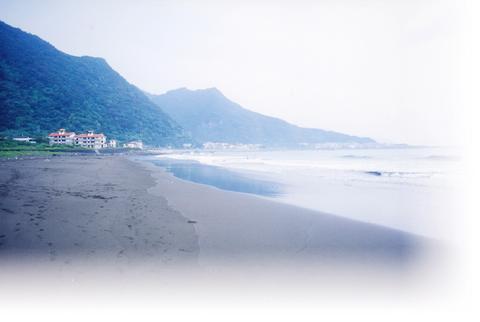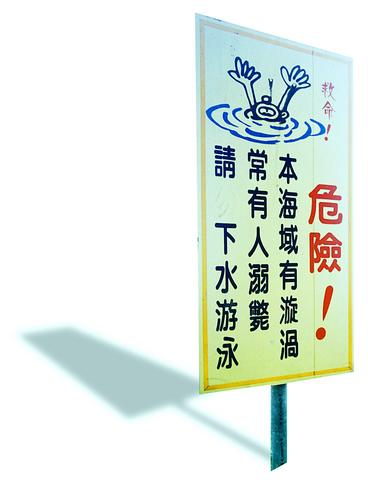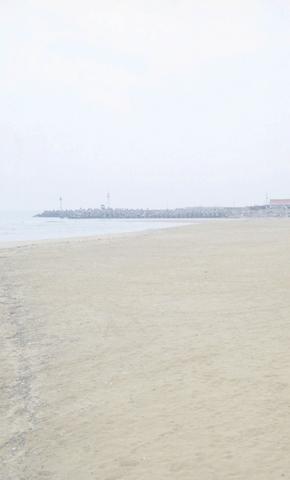The onset of summer, which officially begins later this week, comes with beach season already in full swing. But as weekend vacationers in northern Taiwan head to the coast, they need to be aware that the waters of the eastern seaboard are often treacherous.
Every year people drown, though complete statistics of accidents are not available. The Northeast Coast Tourism Bureau (

According to the bureau's Chang Ching-an (張慶安), "most people who drown either can't swim or are weak swimmers. Often, they wade out to where the water is about chest height, then a wave will come and suddenly they can't touch bottom anymore, then they panic."

Learning to swim is not a compulsory part of Taiwan's education system as it is in some school systems in North America and Europe. To deal with a beach-going public that can't swim, Taiwan's coastal authorities tend towards extreme caution.
Ocean swimming is only recommended at specific pay beaches with lifeguards, who often will blow their whistles if you get more than 30m out to sea. Swimming in any other areas is officially considered "dangerous."

If this seems exasperating for those who know a thing or two about water safety, you should remember that Taiwan's beach culture is only about a dozen years old. During the martial law era, many beaches were strictly off limits as they were considered to be the national defense perimeter. Even in the early 1990s, some foreign residents report having been kicked off beaches by patrolling soldiers who told them they were not allowed to be there.
In spite of all this, a beach culture has slowly evolved. There are a number of beaches easily accessible from Taipei, and thousands flock to them each weekend.
While many of the developed coastal areas are watched over by overbearing lifeguards, several beaches are still more or less au natural -- completely undeveloped and without lifeguards. Some of the most popular are outside Taipei County in Ilan, like the increasingly popular Honeymoon Bay.
Honeymoon Bay is a black sand beach about two hours from Taipei by the local express trains of the Taiwan rail system. The station itself is called Tahsi, and the beach of fine black sand is visible from the station and only about 10 minutes away by foot.
Like many other beaches along the northeast coast, the entrance to Honeymoon Bay is guarded by signs instructing you not to swim there. Like Fulung, Honeymoon Bay is the unfortunate site of numerous drownings, and like many other spots along the coast, it's hard to say exactly how many.
The on-duty officer at the local police precinct said only that he had been stationed in Tahsi for three years, and that during that time, no one had drowned. There were, however, two suicides in which people hurled themselves from cliffs or tall, projecting volcanic rocks along the shoreline into the swirling waters below.
When asked to check the records for the past 10 years, the officer said he wasn't sure if there were any, then he recommended I walk across the street to ask Jeff Sun, the owner of the surf shop across the street.
Personally, I remember hearing of at least three drownings at Tahsi, both of which occurred about four or five years ago. One instance involved a pair of brothers, both under the age of 10. Momentarily unsupervised, they were swept off their feet by undertow or else moved into deep water by currents near the shore.
The other instance was a man whose towel, sandals and other belongings were found by a friend of mine on the beach at Honeymoon Bay on a Monday afternoon. There was no sign of the man, however. Moreover, the waves during the preceding weekend had been fairly large, as a tropical system was moving through. In the end, the situation was reported to the local police, who called in other agencies to search for the man's body (a whole bevy of scuba divers was seen there on the day following the report), which was never found.
On the way to the surf shop, the proprietress of Tahsi's main supermarket, who's something of a town information purveyor, confirmed my suspicion that the police were both hiding information and lazy. She said didn't have any firm recollection of how many had drowned over the years, but remembered that within the last seven or eight years, there was a string of three or four years in a row during which multiple deaths occurred.
Generally, the deep waters of the Pacific are not far off Taiwan's eastern coastline. At Honeymoon Bay, the drop--off is even closer in, which brings in bigger waves and stronger ocean currents. Not surprisingly, the beach is also home to the largest surfing community in Taiwan.
Jeff Sun, who basically pioneered the surfing industry in Taiwan, has run a surf shop there since 1979. When I got to his shop, however, he wasn't there. He was out surfing. I did run into him a little later though when I was on my way down to the beach, and when I asked him how many people had drowned over the years at Tahsi, all he could do was shake his head and say, "too many."
Currents and Rip Tides
Because Taiwan's Pacific coast drops off fairly quickly into deep water, many spots have strong currents or rip tides. A rip tide is a strong narrow current heading directly out to sea, and as a general rule, the bigger the waves, the stronger the rips. If you are ever caught in a rip tide, do not attempt to swim against it. Instead, swim parallel to the shore (it usually only takes a few meters) until you are out of the current, then swim back in to the beach. Other currents can move sideways along the coast, and you can often feel these in water that is only knee deep. Generally, strong currents can always be dangerous.
Big Waves
In the summertime, if there are big waves along the coast, they were generated by some tropical system, whether it be a distant typhoon or a nearby tropical depression. Often, small or distant weather systems will not be reported in the local media, though they still affect the coastline. The major danger of large waves is that they intensify ocean currents. A beach that may be free of rip tides when there are small waves may develop intense rips when the waves get bigger.
Jellyfish
Fortunately there are no lethal jellyfish in Taiwan's coastal waters, according to Luo Wen-chen, a professor at Kaohsiung's National Sun Yat-sen University. Luo, who studies several varieties of jellyfish, said that most jellies which swim into Taiwan's coastal waters in summertime are of the bee sting variety. These include the aurelia aurita, also known as the moon jelly or common sea jelly, and three or four small jellyfish that belong to the siphonophore family. There are few varieties of jellyfish with stronger poison to watch out for, though these are fairly rare. Among them is the cyania sp, or lion's mane jelly, which has a very painful sting, though it is not fatal (except in cases where the person stung is allergic). Jellyfish are more common around river mouths and reefs, where they find more food. They also like relatively placid waters, and in several coastal areas, they become more numerous during extended calm spells. The first incoming swells of a typhoon, however, will send them swimming back out to sea.
Getting help
Dialing 119 (or 110 from some mobile services) is the quickest way to alert the authorities and get help in the event of an accident. Along the east coast, there are hospitals in Gungliao, Toucheng and Keelung.

In the March 9 edition of the Taipei Times a piece by Ninon Godefroy ran with the headine “The quiet, gentle rhythm of Taiwan.” It started with the line “Taiwan is a small, humble place. There is no Eiffel Tower, no pyramids — no singular attraction that draws the world’s attention.” I laughed out loud at that. This was out of no disrespect for the author or the piece, which made some interesting analogies and good points about how both Din Tai Fung’s and Taiwan Semiconductor Manufacturing Co’s (TSMC, 台積電) meticulous attention to detail and quality are not quite up to

April 21 to April 27 Hsieh Er’s (謝娥) political fortunes were rising fast after she got out of jail and joined the Chinese Nationalist Party (KMT) in December 1945. Not only did she hold key positions in various committees, she was elected the only woman on the Taipei City Council and headed to Nanjing in 1946 as the sole Taiwanese female representative to the National Constituent Assembly. With the support of first lady Soong May-ling (宋美齡), she started the Taipei Women’s Association and Taiwan Provincial Women’s Association, where she

Chinese Nationalist Party (KMT) Chairman Eric Chu (朱立倫) hatched a bold plan to charge forward and seize the initiative when he held a protest in front of the Taipei City Prosecutors’ Office. Though risky, because illegal, its success would help tackle at least six problems facing both himself and the KMT. What he did not see coming was Taipei Mayor Chiang Wan-an (將萬安) tripping him up out of the gate. In spite of Chu being the most consequential and successful KMT chairman since the early 2010s — arguably saving the party from financial ruin and restoring its electoral viability —

It is one of the more remarkable facts of Taiwan history that it was never occupied or claimed by any of the numerous kingdoms of southern China — Han or otherwise — that lay just across the water from it. None of their brilliant ministers ever discovered that Taiwan was a “core interest” of the state whose annexation was “inevitable.” As Paul Kua notes in an excellent monograph laying out how the Portuguese gave Taiwan the name “Formosa,” the first Europeans to express an interest in occupying Taiwan were the Spanish. Tonio Andrade in his seminal work, How Taiwan Became Chinese,